Like a sprawling carpet of moss, the Amazon Rainforest stretches from the Atlantic Ocean to the foothills of the Andes, creating a lush basin that still remains partially unexplored to this day. Cut by thin ropes of water flowing from the Amazon River, the forest stretches over land in Colombia, Peru, Brazil, Bolivia, Ecuador, Venezuela, Guyana, Suriname, and French Guiana.
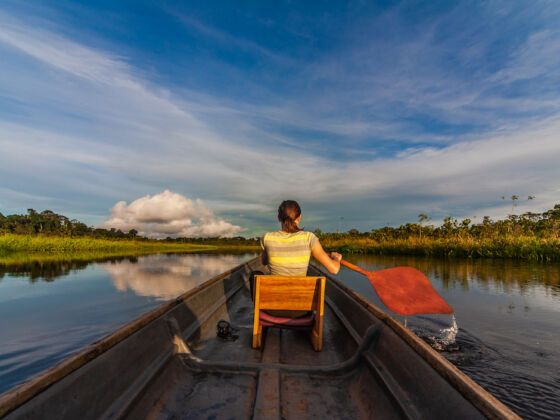

You Can Visit the Colombian Amazon for as Little as $50 Per Day
The basin covers roughly the same area as the contiguous United States, 40 percent of the entire continent of South America, yet nearly all Amazon tourism comes from two nations: Brazil and Peru. Meanwhile, the often overlooked Colombian Amazon Rainforest tempts travelers that are seeking diverse wildlife, or immersive and budget-friendly excursions into the depths of the ancient rainforest.
Leticia, an unpolished jungle town coined “The Gateway to the Amazon ” by locals, sits surrounded by thick primary forest on all sides offering easy access to the Amazonian Basin through guided tours and DIY exploration. Only accessible by domestic flight from the capital city of Bogota, Leticia is tucked into the far-flung southeastern corner of the country. Often destinations this remote and lacking traditional tourist infrastructure come with an impossibly high price tag. But fortunately, while Colombia experienced a major boom in tourism over the last decade, its Amazonian region did not. This has kept prices in Leticia low, while also preserving the authentically Colombian ambience of the small jungle town.
You’ll share the streets with local Colombians from larger cities, like Bogota and Medellín, looking to explore the more wild and rugged side of their home country. Instead of tourist markets selling trinkets you’ll find fruit vendors serving fresh-pressed açaí in styrofoam cups, piping hot buttery buñuelos, and perfectly charred fish plucked straight from the Amazon river. This heavy domestic tourism influence, rather than a focus on international visitors, has protected the extensive species of indigenous flora and fauna as well as being a driving force for budget-friendly trekking excursions, tours, and eco-lodges.
Why tourism is important to the Amazon Rainforest
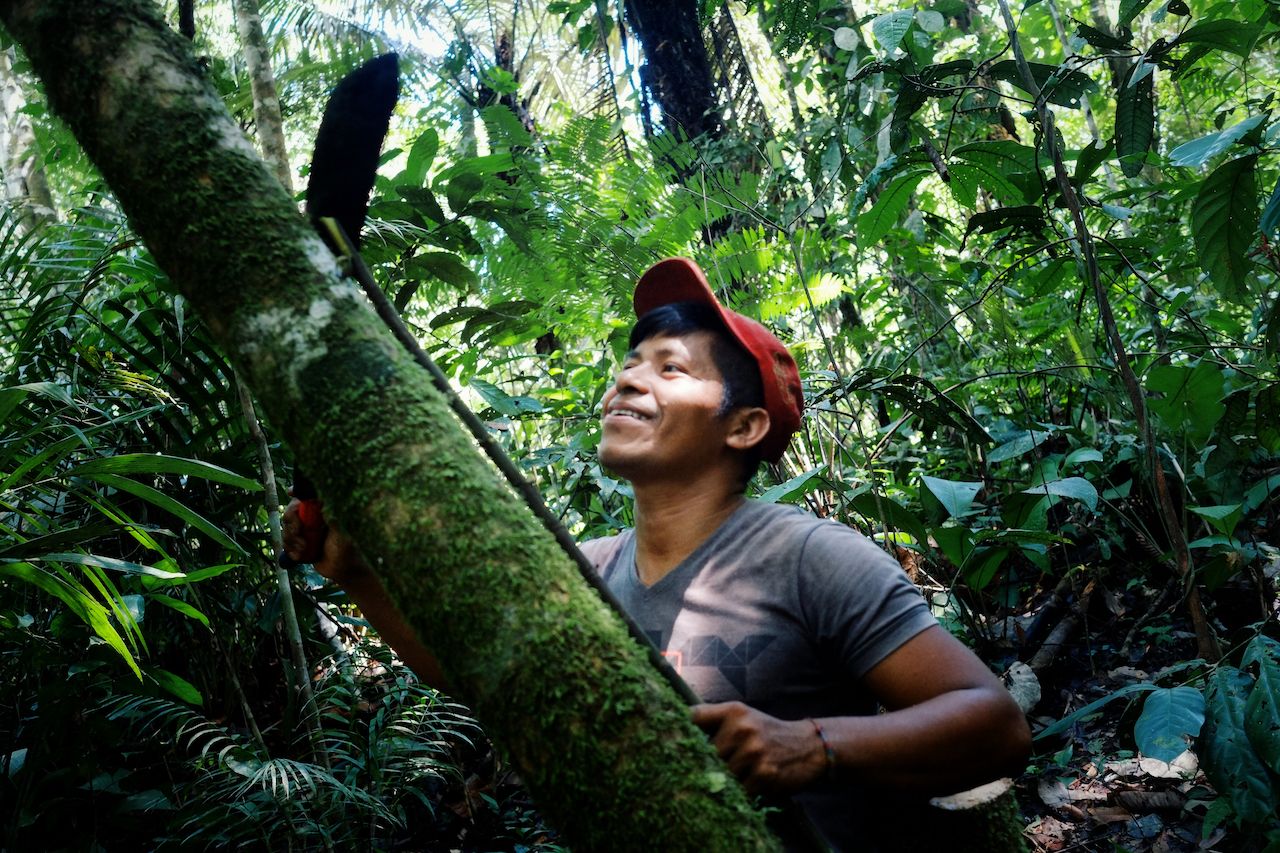
Photo: Laszlo Mates/Shutterstock
The Amazon Rainforest is one of the last unspoiled and untamed natural wonders of the world. About 390 billion individual trees, some a thousand years old, act as the lungs of our planet and have created one of the most biodiverse regions on Earth. It’s a landscape environmentalists across the globe fight to preserve. Deforestation due to the logging and cattle industries, as well as the destructive fires spurred on by an ever-warming climate, threaten this delicate landscape. But tourism to small, often eco-conscious towns like Leticia and nearby Puerto Narino, can help save the rainforest and the cultural practices of its indigenous communities by putting money directly into the hands of those who care deeply for its preservation.
Why Leticia is the best choice for backpacking the Colombian Amazon Rainforest

Photo: Andres Avecedo/Shutterstock
The jungle town sits at the international junction known as “Tres Fronteras,” separated by a wide ribbon of dark water known as the Amazon River, where the countries of Colombia, Brazil, and Peru collide. Leticia is the ideal jumping off point for an Amazon adventure because sitting smack-dab in the middle of the rainforest, you’ll forgo costly transportation and support indigenous guides, all while savoring the ease of access you’ll have to wildlife, excursions, and an inside look at life on the Amazon River.
This steady flowing river is the lifeblood of civilization in the jungle. It provides food, transportation, employment, and demarks the border of these three countries. Much like the rainforest itself, locals rely heavily on the river and live as close as possible to the water’s edge. The perimeter of Leticia is scattered with stilted riverfront homes connected by wobbly wooden walkways, some 10 feet high.
Leticia locals are cut off from the rest of the country by a thousand kilometers of rainforest; all food, medical supplies, and goods arrive either by air or are floated hundreds of miles down the river to town. No one knows the Amazon region better than they do. That’s why many of these indigenous peoples now work as guides, offering their services for half the price of their Peruvian or Brazilian counterparts.
Getting to Leticia
Leticia and its small single-room airport are quite literally surrounded by rainforest. The only way to reach the city is via airplane from one of Colombia’s major metropolises, primarily Bogota. Fortunately, domestic flights in Colombia are extremely affordable. LATAM offers daily flights to the region at a round-trip price of around $100. Be sure to book on the LATAM Colombia site for the cheapest fares, prices on the English version of the site are inflated.
How much should you expect to spend in Leticia?
A budget traveler in Leticia should expect to pay around $50 to $75 per day on average if staying in guesthouses, eating local food, enjoying the free attractions, and embarking on several guided excursions into the Colombian Amazon.
Most days where you’re simply exploring the city you’ll spend far less. But tours and guides are worth splurging on. For those who opt for the standard day tours, they typically cost around $30 per person. Travelers interested in immersive private tours should expect to pay around $40 per person for each night they want to spend in the jungle.
Where to stay in Leticia
Surprisingly, there’s no shortage of places to stay in the Amazon. Cozy guesthouses, eco-resorts, Airbnbs, and even a hostel can be found within a small radius of the city.
Balancing comfort and cost, the best options in Leticia proper can be found on Airbnb and Booking.com. Here you’ll find guesthouses and even full apartments for as little as $10 to $20 a night, sometimes including a home-cooked breakfast. Be aware that there are many small villages along the river that advertise as “Leticia-based” properties. Use the map function when searching to avoid accidentally booking a guesthouse a canoe ride from town.
What to do in Leticia
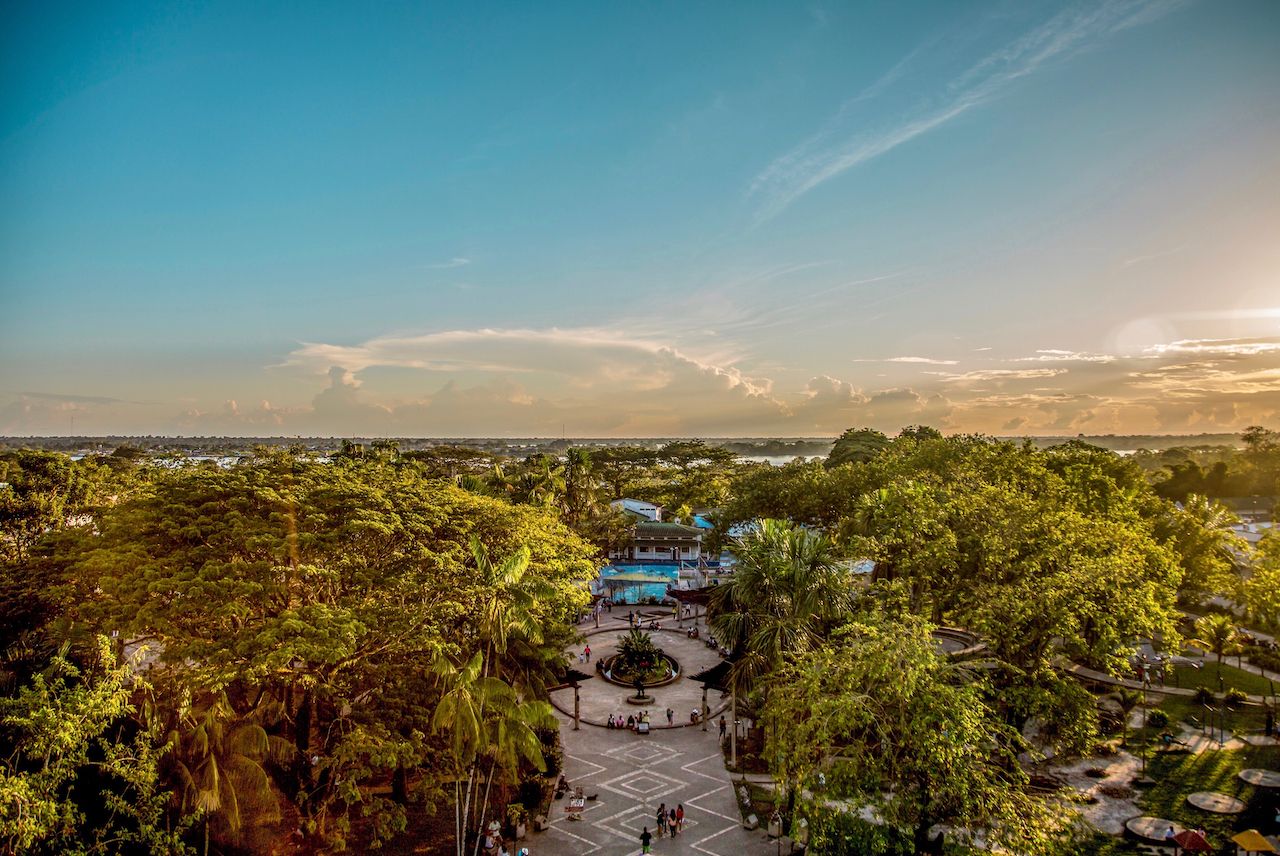
Photo: JaimePorElMundo/Shutterstock
Leticia is a small community easily explored in several days, but it’s not without its charms. A few cracked pavement streets house all the shops, street vendors, a handful of restaurants, an impressive Catholic church, and Parque Santander, where each night hundreds of thousands of screeching parrots come to roost at sundown.
Leticia’s Orellana Park contains a large stone amphitheater for the various town festivals and also hosts an early morning market. The market consists mostly of street food stalls and staple grocery items like sapote, a football-shaped cantaloupe-colored fruit that tastes mildly sweet and soft, and mojojoy, thick writhing grubs ready for frying.
The most interesting activity in Leticia is getting outside of it. It’s while wandering its streets that you’ll encounter guides, small tour operators, and locals willing to help you set up a multi-day excursion into the rainforest. But you can explore the nearby jungle communities without a guide holding your hand. Pressed up against the riverbanks, the network of stilted walkways connecting these villages to town is worth a wander. Life on the Amazon River is remarkably interesting. You’ll witness herds of cattle being floated downstream, a plethora of birds and other wildlife hunting on its shores, and other seemingly mundane tasks made infinitely more fascinating by the challenges the environment poses.
Leticia is a town to be savored, not a list of attractions to be checked off. Because of this, every traveler’s experience in the city will be different. But if you take the time to explore its streets, you’ll gain invaluable insight into life in the rainforest.
Expeditions into the Colombian Amazon Rainforest
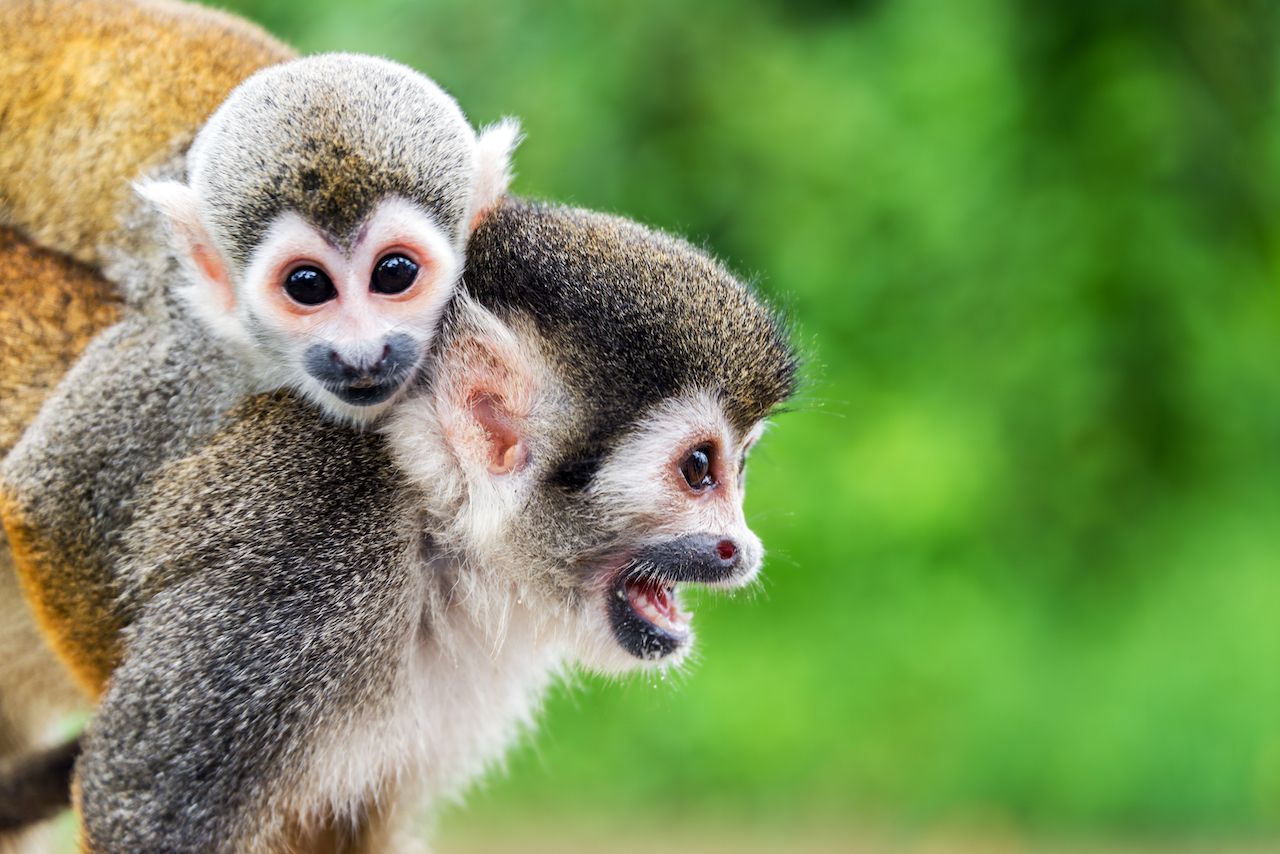
Photo: Jess Kraft/Shutterstock
There are essentially three categories of jungle excursions into the Colombian Amazon.
The “all-inclusive” tour booked in advance often skips over Leticia entirely. These packages offer airport pick-up and transfer to lodging deep in the forest. Many of these are located in the Puerto Narino area. This is the most common Amazon experience for international visitors to Colombia and also the most expensive. If you’re looking for easy, comfortable, immersive, and have a larger budget this may be the route for you.
The “standard group tour” is the most popular option for Colombian visitors. These tours can be booked in advance or last-minute off the street from local travel operators in Leticia. Because the clientele is predominantly Spanish-speaking, you can expect the tours to be in Spanish. The major downside to this option is the sheer number of tourists. Traveling in a massive group of up to 20 people per boat can feel a little watered down if you’re looking for an immersive Amazon experience.
Some attractions easily accessible via group tour from Leticia are Monkey Island or Isla de Los Micos, searching for the elusive pink Amazonian river dolphins, canopy tours in Reserva Natural Tanimboca, or a visit to the eco-friendly village of Puerto Narino. Most of the tours also come with a stop or two at remote villages where locals dress in indigenous garb and perform elaborate ceremonies based on ancient tradition, then sell you some locally-made trinkets before your departure.
Puerto Narino is just a short ride upriver from Leticia and you don’t need to book a tour to visit. Instead, hire a boat from the docks and stay at a guesthouse. There’s no need to book in advance. This remote town is the first Colombian municipality certified as “sustainable” due to its rainforest conservation efforts and eco-friendly energy systems. It also makes a great home base for exploring the surrounding jungle.
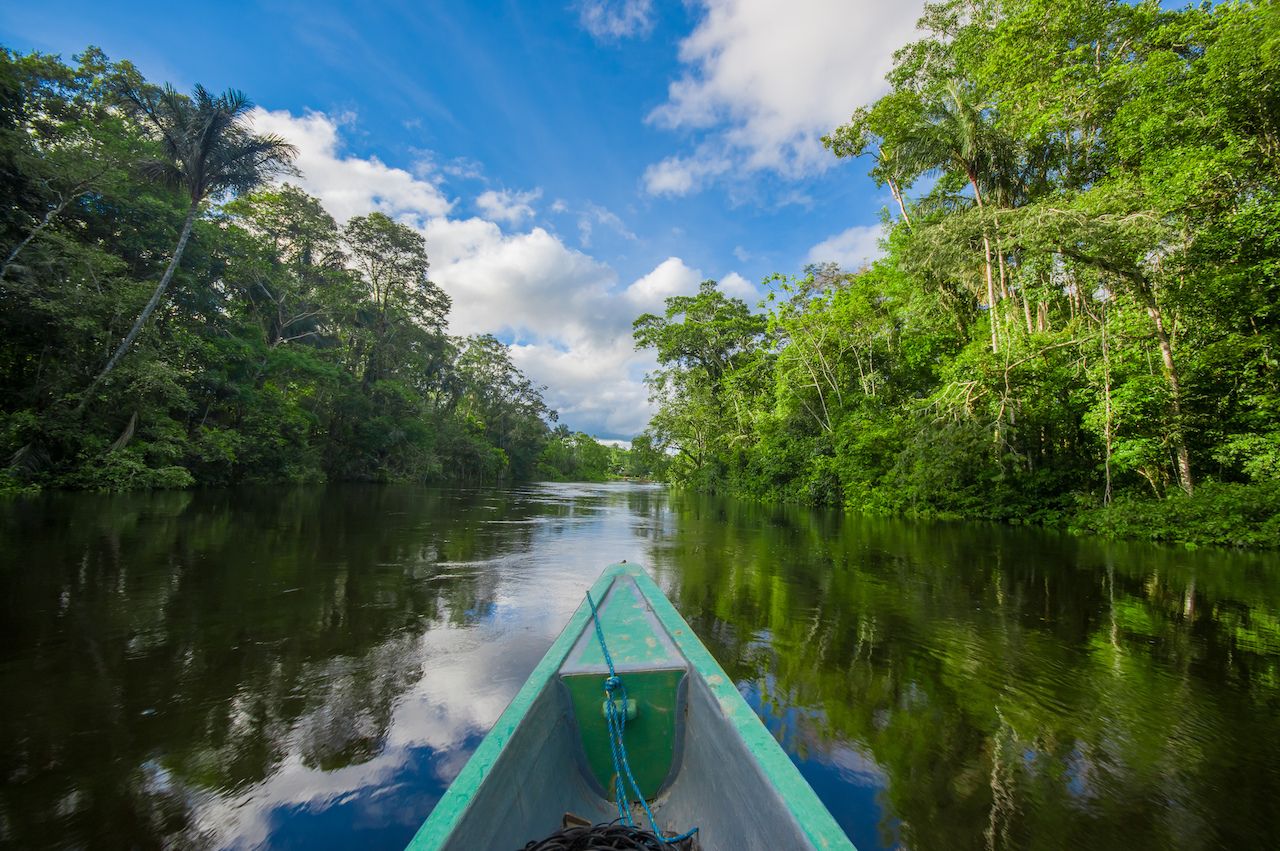
Photo: Fotos593/Shutterstock
Lastly, the “private guided excursion” is as close to DIY as you can get in the rainforest without simply grabbing a tent and walking into the jungle yourself. Guides can be found everywhere in Leticia. Small tourism operators line the main street. Gamboa Excursions is a great company offering overnight or multi-day treks with a private guide into the rainforest.
These adventures can be tailored to your liking. Often including the activities listed above in addition to nighttime caiman hunting, a stopover in Santa Rosa for Peruvian river ceviche, and overnighting in a hammock on a floating platform deep in the rainforest. You’ll also have a greater chance of spotting wildlife like the three-foot-long purple iguanas, brightly-colored macaws, and jovial primates. Typically, this immersive option is rugged and you’ll spend several days hacking through the jungle foliage covered in all kinds of insect life. But it offers a truly intimate experience in the Amazon at the most affordable price.
Regardless of the route you choose, Leticia is an ideal jumping-off point for your Amazon adventure.
Preparing to visit the Colombian Amazon
There are a few precautions to take and things to consider before you embark on an adventure to the Amazon Rainforest, Colombian or otherwise.
Get your Yellow Fever vaccine
Colombia requires travelers to receive the Yellow Fever vaccine before visiting the Amazon. For those in the United States, this can cost anywhere from $250 to $350 and be difficult to track down. Fortunately, Colombia offers the vaccine for free at Bogota International Airport to everyone. Just be sure to receive the vaccination at least two weeks before you head to the Amazon so you’re covered.
Be mosquito ready
Pack light-colored loose-fitting clothing to avoid being bitten through your clothes. It’s recommended you douse your trekking clothes in 90 percent DEET spray before you leave home and bring some low-percentage DEET or natural mosquito repellant for your skin during the trek. Be sure to avoid aerosol sprays due to flight regulations and the environment.
Know the season
The Amazonian basin has two distinct seasons: high water or low water. During the high water season of February to June, the Amazon River spills over its banks and floods the forest floor in up to 20 meters of dark water. During this season you won’t be hiking in the Amazon, instead, you’ll be canoeing through its dense canopy. If your heart is set on hiking be sure to time your visit for between July and January.
Brush up on your Spanish
Aside from the larger tour operators, few residents in Leticia speak English. This can make orchestrating your private guided excursion difficult. Try to brush up on at least the basics before your trip.